职业高中英语第二册Unit9阅读与写作部分教案Book 2 unit9 reading and writing
- 格式:doc
- 大小:58.50 KB
- 文档页数:5
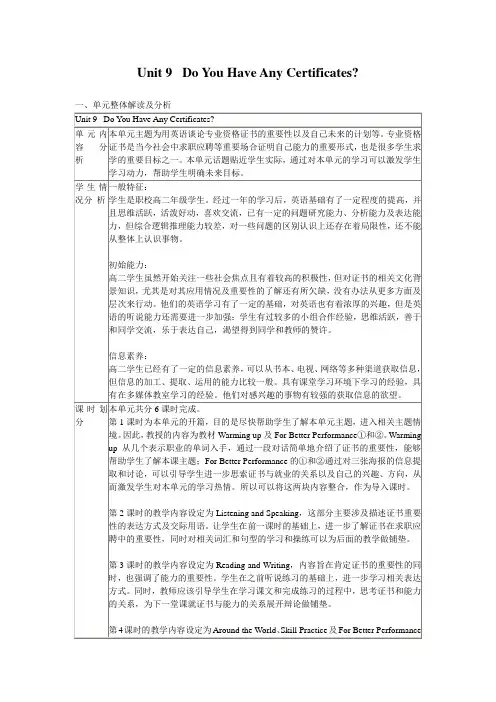
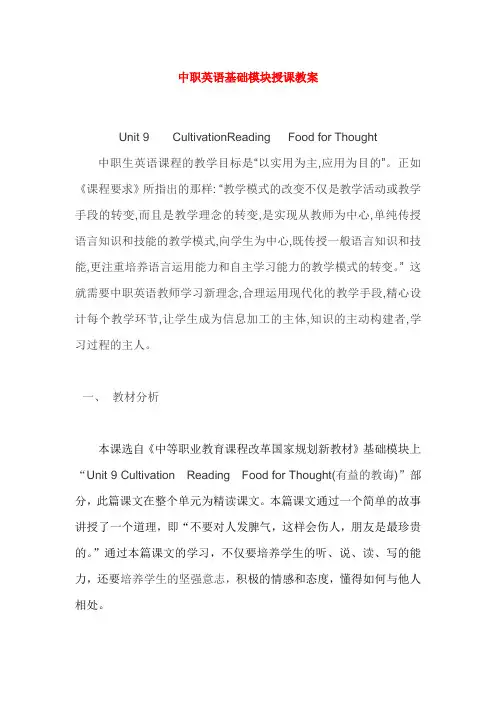
中职英语基础模块授课教案Unit 9 CultivationReading Food for Thought 中职生英语课程的教学目标是“以实用为主,应用为目的”。
正如《课程要求》所指出的那样: “教学模式的改变不仅是教学活动或教学手段的转变,而且是教学理念的转变,是实现从教师为中心,单纯传授语言知识和技能的教学模式,向学生为中心,既传授一般语言知识和技能,更注重培养语言运用能力和自主学习能力的教学模式的转变。
”这就需要中职英语教师学习新理念,合理运用现代化的教学手段,精心设计每个教学环节,让学生成为信息加工的主体,知识的主动构建者,学习过程的主人。
一、教材分析本课选自《中等职业教育课程改革国家规划新教材》基础模块上“Unit 9 Cultivation Reading Food for Thought(有益的教诲)”部分,此篇课文在整个单元为精读课文。
本篇课文通过一个简单的故事讲授了一个道理,即“不要对人发脾气,这样会伤人,朋友是最珍贵的。
”通过本篇课文的学习,不仅要培养学生的听、说、读、写的能力,还要培养学生的坚强意志,积极的情感和态度,懂得如何与他人相处。
二、学情分析我所教的班级是高一的新生,他们大多数英语基础比较薄弱, 运用英语进行交际活动的能力较差,主动学习的动力不够,然而他们的好胜心强,渴望在班集体里得到他人的承认,很在乎别人对他们的评价,求知欲旺盛,思维比较活跃。
因此,只有设置使他们感兴趣的活动,因材施教,尊重学生的个体差异,适应学生的个性发展需求,寻找适应他们的教学策略。
才能使每个学生均学有所得。
三、教学目标1. 认知目标⑴通过课文的学习,掌握下列词汇的用法have fights with lose one’s temper keep one’s temper the number of a number of not … at allbe able to⑵理解宾语从句的构成,it 做形式主语的句式⑶能较流畅地朗读课文,理解课文内容,了解文章的中心思想。
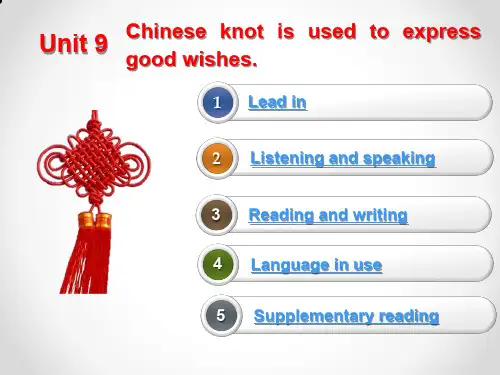
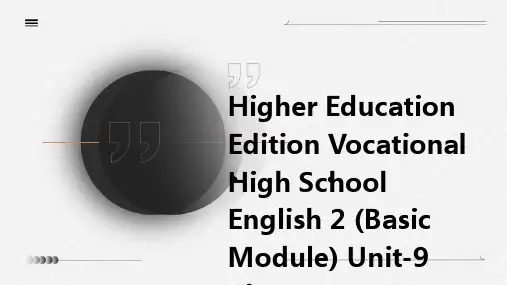
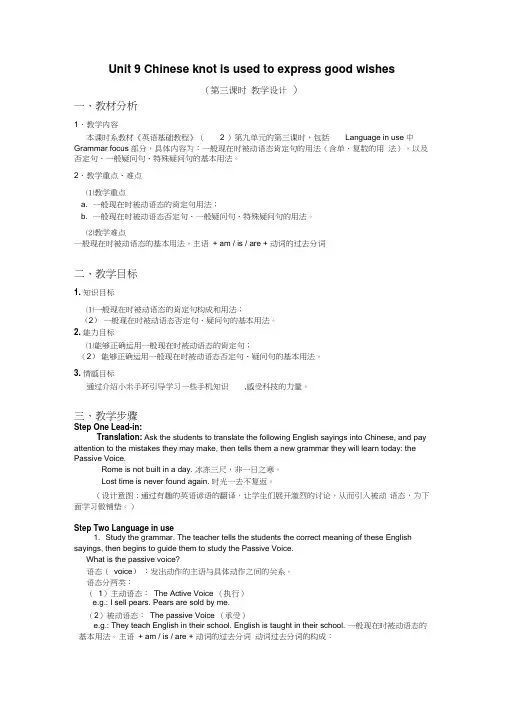
Unit 9 Chinese knot is used to express good wishes(第三课时教学设计)一、教材分析1.教学内容本课时系教材《英语基础教程》( 2 )第九单元的第三课时,包括Language in use 中Grammar focus 部分,具体内容为:一般现在时被动语态肯定句的用法(含单、复数的用法),以及否定句、一般疑问句、特殊疑问句的基本用法。
2.教学重点、难点⑴教学重点a. 一般现在时被动语态的肯定句用法;b. 一般现在时被动语态否定句、一般疑问句、特殊疑问句的用法。
⑵教学难点一般现在时被动语态的基本用法。
主语+ am / is / are + 动词的过去分词二、教学目标1. 知识目标⑴一般现在时被动语态的肯定句构成和用法;(2)一般现在时被动语态否定句、疑问句的基本用法。
2. 能力目标⑴能够正确运用一般现在时被动语态的肯定句;(2)能够正确运用一般现在时被动语态否定句、疑问句的基本用法。
3. 情感目标通过介绍小米手环引导学习一些手机知识,感受科技的力量。
三、教学步骤Step One Lead-in:Translation: Ask the students to translate the following English sayings into Chinese, and pay attention to the mistakes they may make, then tells them a new grammar they will learn today: the Passive Voice.Rome is not built in a day. 冰冻三尺,非一日之寒。
Lost time is never found again. 时光一去不复返。
(设计意图: 通过有趣的英语谚语的翻译,让学生们展开激烈的讨论,从而引入被动语态,为下面学习做铺垫。
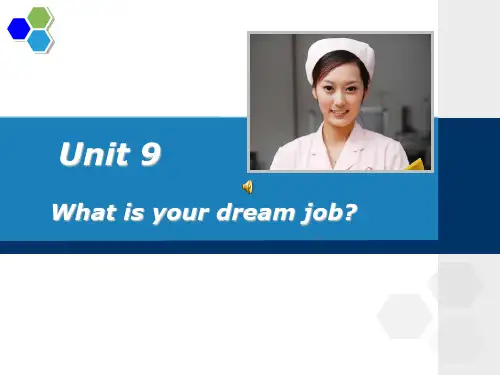
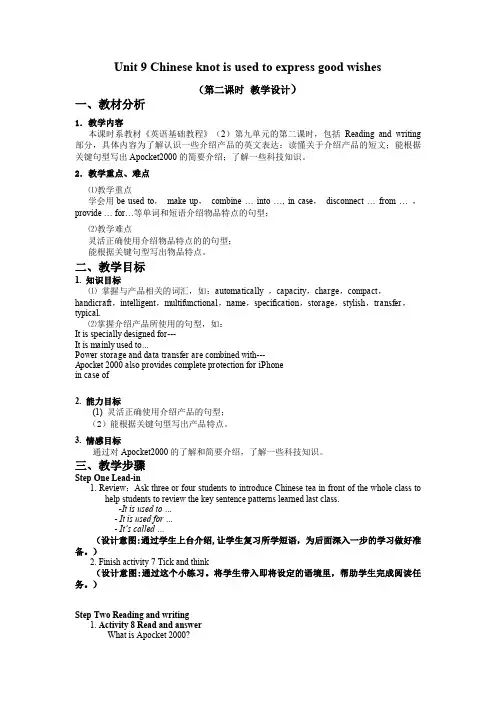
Unit 9 Chinese knot is used to express good wishes(第二课时教学设计)一、教材分析1.教学内容本课时系教材《英语基础教程》(2)第九单元的第二课时,包括Reading and writing 部分,具体内容为了解认识一些介绍产品的英文表达;读懂关于介绍产品的短文;能根据关键句型写出Apocket2000的简要介绍;了解一些科技知识。
2.教学重点、难点⑴教学重点学会用be used to,make up,combine … into …, in case,disconnect … from … ,provide … for…等单词和短语介绍物品特点的句型;⑵教学难点灵活正确使用介绍物品特点的的句型;能根据关键句型写出物品特点。
二、教学目标1. 知识目标⑴掌握与产品相关的词汇,如:automatically ,capacity,charge,compact,handicraft,intelligent,multifunctional,name,specification,storage,stylish,transfer,typical.⑵掌握介绍产品所使用的句型,如:It is specially designed for---It is mainly used to…Power storage and data transfer are combined with---Apocket 2000 also provides complete protection for iPhonein case of2. 能力目标(1) 灵活正确使用介绍产品的句型;(2)能根据关键句型写出产品特点。
3. 情感目标通过对Apocket2000的了解和简要介绍,了解一些科技知识。
三、教学步骤Step One Lead-in1. Review:Ask three or four students to introduce Chinese tea in front of the whole class tohelp students to review the key sentence patterns learned last class.-It is used to …- It is used for …- It’s called …(设计意图:通过学生上台介绍,让学生复习所学短语,为后面深入一步的学习做好准备。
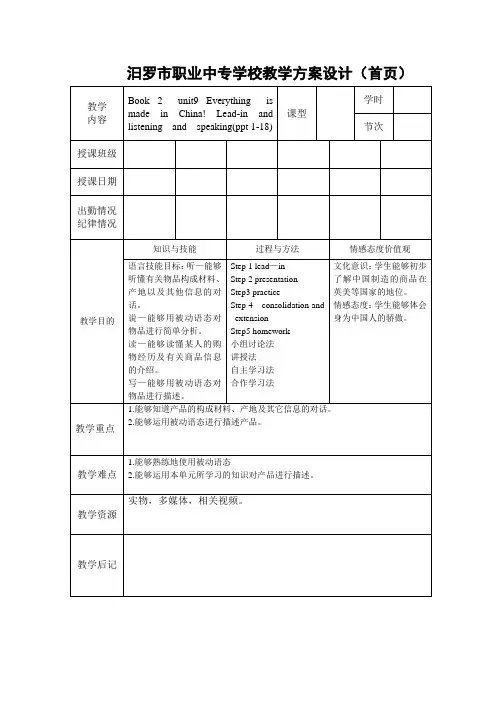
汨罗市职业中专学校教学方案设计(首页)教学内容Book 2 unit9 Everything ismade in China! Lead-in andlistening and speaking(ppt 1-18)课型学时节次授课班级授课日期出勤情况纪律情况教学目的知识与技能过程与方法情感态度价值观语言技能目标:听—能够听懂有关物品构成材料、产地以及其他信息的对话。
说—能够用被动语态对物品进行简单分析。
读—能够读懂某人的购物经历及有关商品信息的介绍。
写—能够用被动语态对物品进行描述。
Step 1 lead—inStep 2 presentationStep3 practiceStep 4 consolidation andextensionStep5 homework小组讨论法讲授法自主学习法合作学习法文化意识:学生能够初步了解中国制造的商品在英美等国家的地位。
情感态度:学生能够体会身为中国人的骄傲。
教学重点1.能够知道产品的构成材料、产地及其它信息的对话。
2.能够运用被动语态进行描述产品。
教学难点1.能够熟练地使用被动语态2.能够运用本单元所学习的知识对产品进行描述。
教学资源实物,多媒体,相关视频。
教学后记汨罗市职业中专学校教学方案设计(正页)教学程序重、难点诠释、教学方法等Step1 lead-inActivity 1 Match the objects with their materials.选用方框中的单词描述图片。
glass cotton plastic wood stone wool silk steel leather1.教师先让学生对着单词表的单词中文意思做题。
2.教师点名检查学生完成情况并给出反馈。
3.教师可以带学生朗读这些句子,让学生初步了解用be made of 表示物品的构成材料,为下面的活动做铺垫。
Activity 2 Match the questions with their answers.将左栏问题与右栏回答匹配,完成顾客与售货员之间的对话。
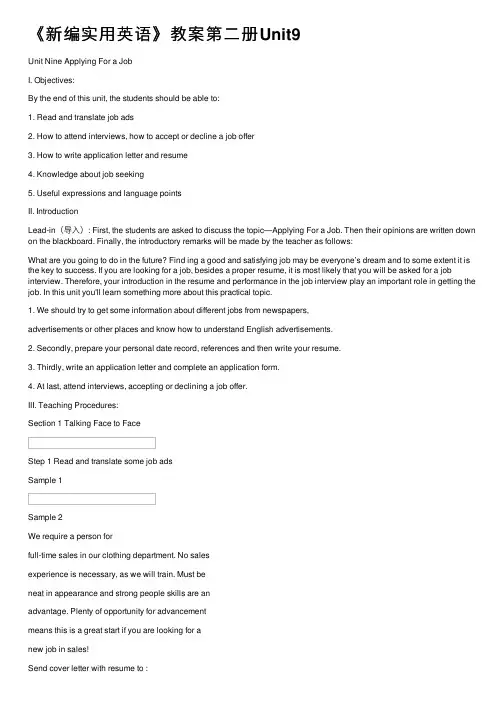
《新编实⽤英语》教案第⼆册Unit9Unit Nine Applying For a JobI. Objectives:By the end of this unit, the students should be able to:1. Read and translate job ads2. How to attend interviews, how to accept or decline a job offer3. How to write application letter and resume4. Knowledge about job seeking5. Useful expressions and language pointsII. IntroductionLead-in(导⼊): First, the students are asked to discuss the topic—Applying For a Job. Then their opinions are written down on the blackboard. Finally, the introductory remarks will be made by the teacher as follows:What are you going to do in the future? Find ing a good and satisfying job may be everyone’s dream and to some extent it is the key to success. If you are looking for a job, besides a proper resume, it is most likely that you will be asked for a job interview. Therefore, your introduction in the resume and performance in the job interview play an important role in getting the job. In this unit you'll learn something more about this practical topic.1. We should try to get some information about different jobs from newspapers,advertisements or other places and know how to understand English advertisements.2. Secondly, prepare your personal date record, references and then write your resume.3. Thirdly, write an application letter and complete an application form.4. At last, attend interviews, accepting or declining a job offer.III. Teaching Procedures:Section 1 Talking Face to FaceStep 1 Read and translate some job adsSample 1Sample 2We require a person forfull-time sales in our clothing department. No salesexperience is necessary, as we will train. Must beneat in appearance and strong people skills are anadvantage. Plenty of opportunity for advancementmeans this is a great start if you are looking for anew job in sales!Send cover letter with resume to :EDGARSHuman Resources manager (⼈⼒资源部经理)126 Prospect Hall roadMississauga, OntarioM4W 1K0Advertisement 1Sample 3Step 2 Read some dialogues about job interview and try to learn how to attend job interview.1.SamplesSample 1 Having a job interviewApril: Hello. Please come in and sit down. Your name is Li Fan, I see. Li: Yes.April:So why don’t you tell me about yourself first, Mr. Li?Li: Uh, certainly. My name is Li Fan. I’m from Shanghai, But I’mliving in Shanghai now. I graduated from Binhai Applied Technology Collegelast year.April: Ok Very good. What job are you applying for?Li: Well, I want to apply for the position advertised by your company---a full time job in sales. April: What courses did you take in your college?Li: My major was clothing design.April: Really? Do you have any sales experiences?Li: Yes. After graduation, I worked as a salesman for a company forone year.April: What about languages?Li: I can speak English very well.April: I see your English is clear, And you dress professionally, too.Hum. Please wait one momentSample 2: Applying for a jobCampos: Come in. Please sit down.Yu: Thanks. Mr. Campos. I'm Yu Lihong.Campos: OK, what can I do for you, Mr. Yu?Yu: I saw your ad for a production technologist yesterday, And Iwant to apply for that position.Campos: Oh, Would you tell me why you are interest in that job?Yu: Well, I got a Mechanical Engineering diploma three years ago,and I've been working in Precascon Mechanical Factory for twoand a half years.Campos: Why do you want to leave (change) the present job?Yu: Well, I'd like to work in a large company like yours that offersmore opportunities for growth (promotion, advancement). Campos: OK. Mr. Yu. It seems that you have the qualifications, Pleasefill out the applications form. You'll be hearing from us withintwo weeks.Yu: Thank you for giving me the chance.Campos: You're most welcome, and good luck.Notes: The most important question for an applicant who want to changehis present job is "why do you want to leave the job?".---Because I like a change, challenge, to widen my experience inthis field ……2. Tasks after class(1)Talk with your partner about your imagined experience as asalesman.(2)Think of a job and tell your partner why you think you are suitablefor it.(3)Tell your friend about your reason for choosing to be a travelingsales agent.(4)Discuss with your partner how to answer the question “Tell usyou idea about this job.”Step 3 Useful sentence patterns about job interview.1.Questions you should think about :1). Why are you interested in the job? Know what kind of person you are, List your advantages over other applicants2). Why do you want to join the company? or what contributions can you make to the company? Know some information about the company (the advantages of the company, some facts about it, the business, the organization, the number of staff, the good future)3). How to sell (present your personality, nature ) yourself confidently? Show your enthusiasm for hard work and your abilities to handle problems.4). How should the applicants behave in an interview? ( walk in quickly, greet warmly, shake hands firmly, sit properly, give no simple yes-no answers and dress professionally.5). How much salary will you expect? What is the salary? May I ask about the salary? 25,000 dollars a year.6). What is the working time? Can you work over time?Work weekdays from 9:00 a.m. to 3: p.m., with half an hour lunch break. (From 5 to 9 p.m. every day except Sundays2. Useful sentences(1) The questions asked by interviewers:(⾯试者询问的问题)Why don’t you begin by telling me something about yourself?先讲⼀下你的个⼈情况,好吗?Would you tell me about your studies?讲⼀下你的学历。
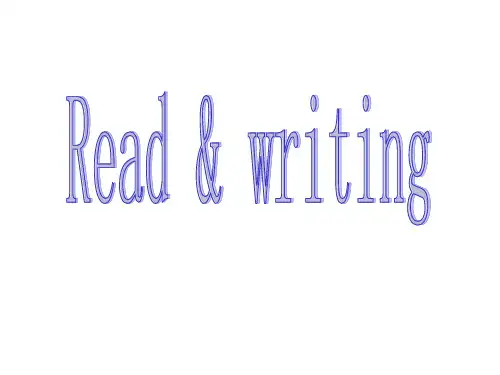
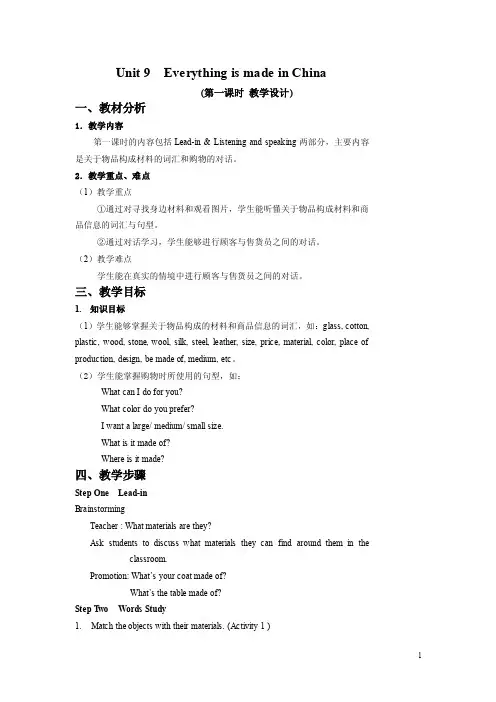
Unit 9 Everything is made in China(第一课时教学设计)一、教材分析1.教学内容第一课时的内容包括Lead-in & Listening and speaking两部分,主要内容是关于物品构成材料的词汇和购物的对话。
2.教学重点、难点(1)教学重点①通过对寻找身边材料和观看图片,学生能听懂关于物品构成材料和商品信息的词汇与句型。
②通过对话学习,学生能够进行顾客与售货员之间的对话。
(2)教学难点学生能在真实的情境中进行顾客与售货员之间的对话。
三、教学目标1.知识目标(1)学生能够掌握关于物品构成的材料和商品信息的词汇,如:glass, cotton, plastic, wood, stone, wool, silk, steel, leather, size, price, material, color, place of production, design, be made of, medium, etc。
(2)学生能掌握购物时所使用的句型,如:What can I do for you?What color do you prefer?I want a large/ medium/ small size.What is it made of?Where is it made?四、教学步骤Step One Lead-inBrainstormingTeacher : What materials are they?Ask students to discuss what materials they can find around them in the classroom.Promotion: What’s your coat made of?What’s the table made of?Step T wo Words Study1. Match the objects with their materials. (Activity 1 )Teacher : Show the words and related pictures of the objects on the screen.Students: Match the objects with their materials.Step Three Listening1. Pre-listeningTeacher: Ask several students about their clothes. The dialogue are as follows:T: What color is your coat?S: It’s ...T: What’s it made of?S: It’s made of ....T: What size is it?S: It’s size L.2. While-listening(1)Listen and answer the questions. (Activity3)(2)Listen again and tick the things they are talking about. (Activity 4)3. Post-listening ( class work and pair work )Step Four Speaking1. Read aloud after the tape and pay attention to the underlined sentences. (Activity 6)Ask students to read the underlined sentences and memorize.What is it made of?It’s made of silk.Where is it made ?I t’s made in China.2. Role play the dialogue between a customer and a shop assistant with the information given. (Activity 7)(1)Teacher makes short dialogues with several students first.Step Five DiscussionTalk about the things you bought recently in pairs.Sample: A: I bought a new scarf last weekend.B: Where is it made?Step Six Homework1. Remember and search more materials about the objects around you.2. Make up a dialogue of asking and giving information about goods.五、板书设计Unit 9 Everything is made in China(第二课时教学设计)一、教材分析1.教学内容本单元阅读活动的目的是训练学生理解描述某人一天购物经历的短文,让学生能在一般的生活、工作语境中使用正确的叙事方式,并能完成相关语言(笔头)输出任务,同时读写活动也为学生完成单元任务作相关的语言准备。
英专综合教程2第⼆版unit9word教案Section One Pre-reading Activities (2)I. Audiovisual supplement (2)II. Cultural information (2)Section Two Global Reading (4)I Text analysis (4)II Structural analysis (4)Section Three Detailed Reading (5)Text I (5)Section Four Consolidation Activities (15)I . Vocabulary Analysis (15)II Grammar Exercises (18)III. Translation exercises (20)IV Exercises for integrated skills (21)V Oral activities (21)VI Writing Practice (22)VII Listening Exercises (24)Section Five Further Enhancement (26)I. Text II (26)II. Memorable Quotes (29)Section One Pre-reading ActivitiesI. Audiovisual supplementWatch the video and answer the following questions.1. What happened to Chris?2. Do you have the experience that you struggled so hard to achieve something, and at last you made it?(插⼊视频)Answers to the Questions:1. It was the last day of Chris‘ internship at a prestigious stock brokerage firm. At last he got the job as a broker. This could change his life. So after meeting the managers, Chris got his happiness.2. Open.Script:Chris:Mr. Frohm, good to see you.Mr. Frohm: Nice shirt.Chris:Thank you, sir.Jay:Chris.Chris:Hey, Jay.Mr. Frohm: Chris, sit down, please.Chris:I thought I‘d wear a shirt today. You know, being the last day and all.Mr. Frohm: Well, thank you. Thank you. We appreciate that. But ... wear one tomorrow though, okay? Because tomorrow‘s going to be your first day. If you‘d like to work here as abroker. Would you like that, Chris?Chris:Yes, sir.Mr. Frohm: Good. We couldn‘t be happier. So welcome. Was it as easy as it looked?Chris:No, sir. No, sir, it wasn‘t.Mr. Frohm: Good luck, Chris.Chris:Thank you. Thank you.Mr. Frohm: Oh, Chris. I almost forgot.Chris:Thank you.Voiceover: This part of my life ... this little part ... is called ―Happiness.‖II. Cultural information1. QuoteHappiness lies not in the mere possession of money; it lies in the joy of achievement, in the thrill of creative effort.— Franklin Roosevelt(适当插⼊图⽚Franklin Roosevelt)2. The Pursuit of HappinessThe Pursuit of Happiness is a 2006 American biographical film directed by Gabriele Muccino about the on-and-off-homeless salesman-turned stockbroker Chris Gardner. The screenplay by Steven Conrad is based on the best-selling memoir of the same name written by Chris Gardner with Quincy Troupe. The film was released on December 15, 2006, by Columbia Pictures.Chris Gardner is a bright and talented, but marginally employed salesman. Struggling to make ends meet, Gardner finds himself and his five-year-old son evicted from their San Francisco apartment with nowhere to go. When Gardner lands an internship at a prestigious stock brokerage firm, he and his son endure many hardships, including living in shelters, in pursuit of his dream of a better life for the two of them.(插⼊图⽚The Pursuit of Happiness)Section Two Global ReadingI Text analysis1.What‘s the author‘s answer to the question ―What is happiness‖?According to the author, happiness lies in the idea of becoming, in the meaningful pursuit of what is life-engaging and life-revealing.2.What‘s the author‘s purpose of writing?To attempt a definition of happiness by setting some extremes to the idea and then working in toward the middle.II Structural analysisSection Three Detailed ReadingText IWhat Is Happiness?John Ciardi(abridged)1The right to pursue happiness is issued to Americans with their birth certificates, but no one seems quite sure which way it runs. It may be we are issued a hunting license but offered no game.1Jonathan Swift seemed to think so when he attacked the idea of happiness as “the possession of being well-deceived,” the felicity of being “a fool among knaves.” For Swift saw society as Vanity Fair, the land of false goals.2It is, of course, un-American to think in terms of fools and knaves.2 We do, however, seem to be dedicated to the idea of buying our way to happiness. We shall all have made it to Heaven when we possess enough.33And at the same time the forces of American commercialism are hugely dedicated to making us deliberately unhappy. Advertising is one of our major industries, and advertising exists not to satisfy desires but to create them — and to create them faster than any man’s budget can satisfy them. For that matter, our whole economy is based on a dedicated insatiability. We are taught that to possess is to be happy, and then we are made to want.We are even told it is our duty to want. It was only a few years ago, to cite a single example, that car dealers across the country were flying banners that read "You Auto Buy Now."They were calling upon Americans, as an act approaching patriotism, to buy at once, with money they did not have, automobiles they did not really need, and which they would be required to grow tired of by the time the next year’s models were released.4Or look at any of the women’s magazines. There, as Bernard DeVoto once pointed out, advertising begins as poetry in the front pages and ends as pharmacopoeia and therapy in the back pages. The poetry of the front matter is the dream of perfect beauty. This is the baby skin that must be hers. These, the flawless teeth. This, the perfumed breath she must exhale. This, the sixteen-year-old figure she must display at forty, at fifty, at sixty, and forever.5Once past the vaguely uplifting fiction and feature articles, the reader finds the other face of the dream in the back matter. This is the harness into which Mother must strap herself in order to display that perfect figure. These, the chin straps she must sleep in. This is the salve that restores all, this is her laxative, these are the tablets that melt away fat, these are the hormones of perpetual youth, these are the stockings that hide varicose veins.6Obviously no half-sane person can be completely persuaded4 either by such poetry or by such pharmacopoeia and orthopedics. Yet someone is obviously trying to buy the dream as offered and spending billions every year in the attempt. Clearly the happiness-market is not running out of customers, but what are they trying to buy?7The idea "happiness," to be sure, will not sit still for easy definitions: the best one can do is to try to set some extremes to the idea and then work in toward the middle.5 To thinkof happiness as acquisitive and competitive will do to set the materialistic extreme.6To think of it as the idea one senses in, say, a holy man of India will do to set the spiritual extreme. That holy man’s ideal of happiness is in needing nothing from outside himself. In wanting nothing, he lacks nothing. He sits immobile, rapt in contemplation, free even of his own body.7Or nearly free of it. If devout admirers bring him food, he eats it; if not, he starves indifferently. Why be concerned? What is physical is an illusion to him.Contemplation is his joy and he achieves it through a fantastically demanding discipline, the accomplishment of which is itself a joy within him.88But, perhaps because I am Western, I doubt such catatonic happiness, as I doubt the dreams of the happiness-market. What is certain is that his way of happiness would be torture to almost any Western man. Yet these extremes will still serve to frame the area within which all of us must find some sort of balance. Thoreau —a creature of both Eastern and Western thought — had his own firm sense of that balance. His aim was to save on the low levels in order to spend on the high.99Possession for its own sake or in competition with the rest of the neighborhood would have been Thoreau’s idea of the low levels. The active discipline of heightening one’s perception of what is enduring in nature would have been his idea of the high.10 What he saved from the low was time and effort he could spend on the high. Thoreau certainly disapproved of starvation, but he would put into feeding himself only as much effort as would keep him functioning for more important efforts.10Happiness is never more than partial.11There are no pure states of mankind.Whatever else happiness may be, it is neither in having nor in being, but in becoming.12 What the Founding Fathers declared for us as an inherent right, we should do well to remember, was not happiness but the pursuit of happiness. What they might have underlined, could they have foreseen the happiness-market, is the cardinal fact that happiness is in the pursuit itself, in the meaningful pursuit of what is life-engaging and life-revealing,13 which is to say, in the idea of becoming.A nation is not measured by what it possesses or wants to possess, but by what it wants to become.Paragraphs 1-2Questions1. What does the author mean when he says ―The right to pursue happiness is issued to Americans with their birth certificates‖? (Paragraph 1)Here the author alludes to the well-known statement in the Declaration of Independence of the United States of America:―We hold these truths to be self-evident, that all men are created equal, that they are endowed by their Creator with certain unalienable Rights, that among these are Life, Liberty, and the pursuit of Happiness.‖ The sentence means that everyone is born with the right to pursue happiness.2. What do the quoted expressions from Swift mean? (Paragraph 1)Both expressions ―the possession of being well deceived‖ and ―a fool among knaves‖ are used by Swift to describe a conception of happiness, i.e., a state of being deceived. The word ―possession‖ here means ―a state of being completely under the influence of an idea or emotion‖and in this particular expression ―the state of being deceived.‖―A fool among knaves‖ refers to a person who is easily deceived without realizing it.3. Why does the author say, ―It is, of course, un-American to think in terms of fools and knaves‖? (Paragraph 2)Because most Americans take it for granted that pursuing happiness, or buying their way to it is in accordance with American national character.Words and Expressions1. pursue vt. try to achieve somethinge.g. He urges all sides in the conflict to pursue peace.We are working together to pursue a common goal.Derivation:pursuit n.Collocation:in the pursuit ofe.g. She showed steadiness and courage in the pursuit of her aims.2. issue vt. to provide sb. with the things they need for a particular actione.g. The police in Britain are not usually issued with guns.Visitors are issued with identity cards to wear inside the factory.Collocation:issue sth. (to sb.) 将某物发给、供给或分配给某⼈使⽤e.g. The office will be issuing permits on Tuesday and Thursday mornings.Derivation:issue n.Sentences1. It may be we are issued a hunting license but offered no game. (Paragraph 1)Explanation: It may be we are given the right of pursuing happiness but we don‘t know where it is, because maybe there is no happiness as such at all. Note ―game‖ originally refers to a wild animal or bird hunted for sport. Here it is a metaphor for what is being pursued, i.e. happiness. It is roughly equi valent to ―false goals‖ at the end of this paragraph.Paraphrase:It may be that you have received the license for hunting but you don‘t have the chance to hunt.Translation: 它可能就像:授予了你打猎的许可证却不给你提供打猎的机会。
I like music that I can dance to(第2课时)一、教学目标:1. 语言知识目标:1) 学习掌握下列词汇:down, dialogue, ending, documentary, drama, plenty, plenty of, shut, shutoff, superhero, once in a while2) 能掌握以下句型:①While some people stick to only one kind of movies, I like to watch different kinds depending on how I feel that day.②When I’m down or tired, I prefer movies that can cheer me up.③But they try their best to solve their problems.④Laughing for two hours is a good way to relax.⑤Documentaries like March of the Penguins which provide plenty of information about acertain subject can be interesting,…⑥I don’t mind action movies like Spider Man when I’m too tired to think.⑦I can just shut off my brain…⑧Once in a while, I like to watch movies that are scary.⑨But I’m too scared to watch them alone.⑩It doesn’t feel so scary anymore.2.能力与发展目标:进一步熟练掌握that/ which/ who引导的定语从句。
教学内容B ook 2 unit9 Everything ismade in China! Language inuse(ppt3 1-61)课型学时节次授课班级授课日期出勤情况纪律情况知识与技能过程与方法情感态度价值观语言技能目标:听—能够Step 1 Review文化意识:学生能够初步听懂有关物品构成材料、Step 2 Lead-in了解中国制造的商品在产地以及其他信息的对Step3Presentation英美等国家的地位。
话。
Step 4 Practice and情感态度:学生能够体会说—能够用被动语态对consolidation身为中国人的骄傲。
教学目的物品进行简单分析。
Step5 homework读—能够读懂某人的购小组讨论法物经历及有关商品信息讲授法的介绍。
自主学习法写—能够用被动语态对合作学习法物品进行描述。
1.能够知道产品的构成材料、产地及其它信息的对话。
2.能够运用被动语态进行描述产品。
教学重点1.能够熟练地使用被动语态教学难点2.能够运用本单元所学习的知识对产品进行描述。
实物,多媒体,相关视频。
教学资源教学后记教学程序重、难点诠释、教学方法等Step1 Review1.使学生默写上节课所学习的单词,可以让学生之间相互检查。
也可以喊学生上黑板默写,其他的学生在自己的座位默写.2.让学生背诵Everyday English.喊不同层次的学生回答,给予不同的奖励。
3.学生说出自己所做的activity 14 文章。
Step 2 lead -inGrammar focus通过例句呈现The scarf is made of silk.一般现在时态Milk is produced on the farm.Pans are used for cooking.被动语态的基本结构和用Shoes are made in China.法,朗读加深Where is it produced?印象。
What is it used for?1.学生自己阅读方框中的句子。
教学内容Book 2 unit9 Everything ismade in China! Reading andwriting (ppt 19-30)课型学时节次授课班级授课日期出勤情况纪律情况教学目的知识与技能过程与方法情感态度价值观语言技能目标:听—能够听懂有关物品构成材料、产地以及其他信息的对话。
说—能够用被动语态对物品进行简单分析。
读—能够读懂某人的购物经历及有关商品信息的介绍。
写—能够用被动语态对物品进行描述。
Step 1 ReviewStep 2 Lead-inStep3 PresentationStep4Practice andconsolidationStep5 homework小组讨论法讲授法自主学习法合作学习法文化意识:学生能够初步了解中国制造的商品在英美等国家的地位。
情感态度:学生能够体会身为中国人的骄傲。
教学重点1.能够知道产品的构成材料、产地及其它信息的对话。
2.能够运用被动语态进行描述产品。
教学难点1.能够熟练地使用被动语态2.能够运用本单元所学习的知识对产品进行描述。
教学资源实物,多媒体,相关视频。
教学后记教学程序重、难点诠释、教学方法等Step 1 Review1.请学生默写单词,然后同桌之间相互检查。
2.请几组学生朗读activity 6 的对话,然后其它的学生给予评价。
Step 2 Lead-in1教师先组织四人一组就中国制造的话题展开讨论,以此激发学生对阅读活动的兴趣。
1)China produces most of the products for the World .What do you think of it?2)Do you think China is already a powerful country in terms of its economic strength?2.Look at the picture and answer questions.看图回答问题。
1)Where did the story take place?2)How did the lady feel?Step 3 PresentationEveryday EnglishWhat can I do for you? 我能为你做些什么?What color do you prefer? 您喜欢什么颜色?I want a large / medium / small size. 我想要一个大/中/小号。
What is it made of? 它是什么材质的?Where is it made? 它是哪里生产的?1.教师先让学生读每一个句子,然后让其他的学生提出问题,教师帮助解答2.教师带领学生读句子,使学生熟练句子。
3.教师给予学生几分钟的时间记忆Everyday English。
4.请学生背诵Every English.vocabulary Learningscarf sort suddenly notice candle living room Label screen mall fashionable refrigerator1.先由学生自己看着音标拼读单词。
2.教师点名学生读单词,对于读错的单词给予纠正。
3.教师带读单词4.给予学生几分钟的时间,自己练习读单词5.教师检验学生掌握单词的效果,可以教师说中文,学生说英文Activity 10 Read and match the main idea for each paragraph。
阅读短文,并将每段与其段落大意匹配。
Paragraph 1 The shopping experience surprised Mrs. Lawson. Paragraph2 Mr. Lawson gave Mrs. Lawson the biggestsurprise.Paragraph 3 Mrs. Lawson found something interesting aboutthe Christmas gifts.Paragraph 4 The labels in the living room made Mrs. Lawsonvery surprised.1.学生先读第一遍短文,找出每一自然段的段落大意。
2.教师点名检查并在全班给出检查3.学生再仔细读一遍短文,提出不懂的问题。
4.教师和学生一起解答疑难。
5.教师仔细讲解课文6.给予学生时间,再一次阅读短文,有不懂的地方提出来,进行解答。
7.教师带学生读课文。
8.学生自己朗读课文。
Activity 11 Read the passage again and tick the things made in China. 再读上面的文章,并选出中国制造的商品。
Activity 12 Complete the chart about Mrs. Lawson’s day.再读文章,完成Lawson太太一天活动的表格。
Time Place ActivitiesAfter breakfast her son’s room SortChristmas gifts1.学生再读短文,获取主要信息并填表格。
2.两人一组讨论填充的内容。
Step 4 Practice and consolidation.Activity 13 Use the given phrases to describe Allison’s shopping day.利用所给关键词描述下列图片,讲述Alison一天的购物经历。
每图限用两句话。
1.学生两人一组一起讨论每幅图的描述。
2.教师点名学生检查学生的完成情况。
3.师生一起核对答案,并对重点词句进行讲解。
1)After breakfast, Allison went to a big shopping mall to buy a CD player.She found a very good one designed just for young ladies.2)At noon, Allison went to a department store.She found a dress made of silk and it wasn’t expensive.3)In the afternoon, Allison went to a supermarket to buy a pair of sunglasses.They were fashionable.4)In the evening, Allison went back home.She was surprised to find that all things she bought were made in China.Activity 14 Write a short passage about Allison’s shopping day.把活动13中的连成一段,描述Alison的购物经历。
Alison’s Shopping DayAfter breakfast, Allison went to a big shopping mall to buy a CD player. She found a very good one designed just for young ladies. 可以以小组讨论的形式展开。
教师讲解阅读材料中重要的表达方式。
可以让学生先在小组内说。
学生把活动13中的句子组合在一起,成为一个小文段。
教师点名检查学生的完成情况并给出反馈。
重难点的词汇和句型:1.Where did the story take place?故事发生在什么地方?take place 发生举行Eg:The accident took place last night.The concert will take place next Friday.2.After breakfast, Mrs. Lawson started to sort all the gifts in her son’s room. 吃过早饭过后,劳森太太来到她儿子的房间,开始整理所有的圣诞礼物。
Sort v. 分类,整理Eg: The boy is sorting the foreign stamps he has collected.男孩正在整理他搜集来的外国邮票。
Sort these cards according to their colors.按照颜色把这些卡片分类。
3.After lunch, she drove to a shopping center to buy a pair of new shoes for her son and candles for her daughter’s birthday cake. 吃过午饭,他开车来到一家购物中心,想要给她的儿子买一双鞋子,再买些蜡烛给女儿过生日用。
drove 是动词drive 的过去式形式,意为“驾驶,开车”Eg:Don’t drive so fast! 别开得那么快!I drove to work this morning.我今天早上开车去上班上的班。
a pair of 一副,一双,一对A pair of eyes / earrings / gloves / glasses一双眼睛;一对耳环;一副手套;一副眼镜4.She was surprised to find that all the shoes there were from China and all the candles were also from China.她惊讶地发现所有的鞋子都来自中国,所有的蜡烛也都来自中国。
Surprised adj 感到意外的,感到惊讶的Eg:I’m surprised to hear you say that.听到你那么说我感到很惊讶。
5.“Well, that’s surprising!”, said Mrs. Lawson to herself.劳森太太自言自语道:“太奇怪了!”Surprising adj “令人吃惊的,使人惊奇的”Eg:It’s not surprising that they lost.他们输了,这并不奇怪。
Say to oneself 自言自语6.she looked around and was even more surprised. 他环顾四周,感到很惊奇。
Look around 环顾四周,四下张望相当于look roundEg: I'm going to look around and see what I can find. 我去四下里转转,看看能发现些什么。